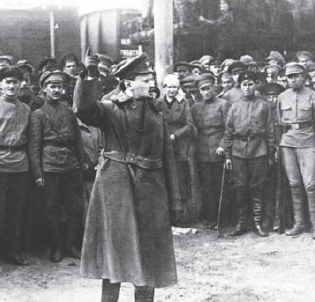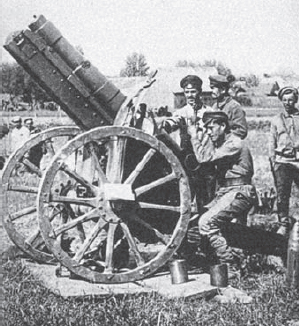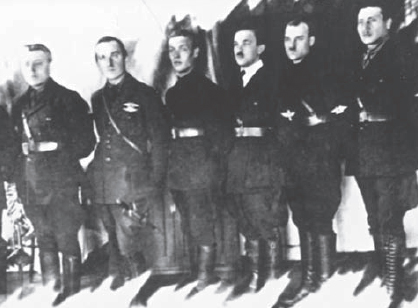
The Workers’ and Peasants’ Red Army (Raboche-Krest’yanskaya Krasnaya Armiya – RKKA) was formed on 28 Jan 1918 from the paramilitary Red Guard, with the Workers’ and Peasants’ Red Air Force (Raboche-Krest’yanskii Krasnyi Voenno-Vozdushnyi Flot – RKKVF) as an integral element. The Red Navy (RKKF) was established on 11 Feb 1918. At first enlistment was voluntary, but conscription was introduced on 29 May 1918. Following the patriotic appeal by ex-Gen Brusilov on 30 May 1920, about 315,000 Tsarist officers were drafted into command positions, usually with the title of ‘military specialist’ (Voyenni spetsialist – abbreviated Voyenspets), but always supervised by a political officer (Politicheskiy rukovoditel – Politruk) of the same rank.

Leon Bronshtein (‘Trotsky’), People’s Commissar for Army & Navy Affairs, addressing troops in 1920. Trotsky wears a Russian M1910 peaked cap with M1918 red star, while his audience are wearing Tsarist caps, field shirts, breeches, and boots or puttees; note the military nurse immediately right of Trotsky. The absence of cap badges or other insignia suggests that these are former Imperial and Republican Army officers who volunteered as ‘military specialists’ after May 1920 in order to stem the Polish advance. As Stalin’s most dangerous rival, Trotsky was deposed politically in January 1925, and eventually murdered in exile in Mexico City in August 1940. (Library of Congress)
The Council of People’s Commissars (abbreviated Sovnarkom) was chaired by Lenin. Leon Bronshtein (‘Trotsky’) controlled the armed forces from 13 Mar 1918 as People’s Commissar for Army & Navy Affairs. On 2 Sept 1918 the Army & Navy High Command became the Revolutionary Military Council of the Republic (Revvoyensovyet), chaired by Trotsky. The first Red Army Commander-in-Chief (Glavniy komanduyushchiy – Glavkom) was the Latvian communist Joachim Vatsetis, appointed on 1 Sept 1918, but succeeded on 9 July 1919 by Sergey Kamenev.
During the Russian Civil War (7 Nov 1917–25 Oct 1922, and thus partly simultaneous with the events covered in this book) the Military Council struggled to maintain 11 Military Districts, each of which was intended to supply a Front: White Sea (Arctic), Far Eastern, Kiev (Ukr, Kyiv), Moscow, North Caucasus, Odessa (Ukr, Odesa), Orel, Petrograd (Rus, St Petersburg), Ural, Volga, and Yaroslavl. Odesa and Kyiv districts were in fact often under UNR control.
WESTERN FRONT (3 Oct 1918–13 Mar 1919; 18 June 1919–12 Oct 1920)
Sixteenth Army (11 Sept–14 Nov 1918) / Western Army (15 Nov 1918–12 Mar 1919) / Lithuanian-Belarusian Army (13 Mar–8 June 1919) / Sixteenth Army (9 June 1919–Oct 1920): Pskov/Lithuanian Rifle Div (Nov 1918–May 1919) / 4 Rifle Div (June 1919–Sept 1920); International / Western) Rifle Div (Nov 1918–June 1919) / 52 Rifle Div (June–Nov 1919); 17 Rifle Div (Nov 1918–Sept 1919; Sept 1919–Oct 1920); 8 Rifle Div (Jan 1919–Oct 1920); 53 Rifle Div (May–July 1919); Latvian Soviet Rifle Div (June 1919); 29 Rifle Div (Mar–May 1920); 57 Rifle Div (Mar–June 1920); 21 Rifle Div (May–June 1920); 2 Rifle Div (June–Aug & Oct 1920); 27 Rifle Div (June–Aug & Oct 1920); 48, 55 Rifle Divs (Aug–Sept 1920); 56 Rifle Div (Sept–Oct 1920); 16 Rifle Div (Oct 1920); 2 Border Guard Div (Nov 1918–July 1919).
Fifteenth Army (7 June 1919–4 Oct 1920): Lithuanian Rifle Div (May–June 1919); Latvian Soviet Rifle Div (June–Sept 1919); 10 Rifle Div (Mar–Sept 1920); 11 Rifle Div (June 1919–Oct 1920); 17 Rifle Div (Sept 1919); 53 Rifle Div (Sept 1919–July 1920); 19 Rifle Div (Oct 1919–Jan 1920); 21 Rifle Div (Dec 1919–May 1920); 2 Rifle Div (Dec 1919–Jan 1920; Aug–Oct 1920); 21 Rifle Div (Dec 1919–May 1920); 48 Rifle Div (Jan–July 1920); 56 Rifle Div (Apr–June & Oct 1920); 12, 29 Rifle Divs (May–June 1920); 5 Rifle Div (May–July 1920); 6 Rifle Div (May–June 1920); 18 Rifle Div (May–July & Oct 1920); 54 Rifle Div (June–Aug 1920); 33 Rifle Div (June–Oct 1920); 16 Rifle Div (July–Oct 1920); 27 Rifle Div (Aug–Oct 1920); 12, 15 Cav Divs (Apr–June & June–Sept 1920); 10 Kuban Cav Div (Aug–Sept 1920).
Twelfth Army (16 June–16 Oct 1919; 14 Aug–26 Sept 1920): 1 Ukrainian Soviet Rifle Div (June–Aug 1919) / 44 Rifle Div (Aug 1919–Apr 1920; June–Oct 1920); 45 Rifle Div (June–Oct 1919); 46 Rifle Div (June–Aug 1919); 47, 58, 60 Rifle Divs (Sept–Oct 1919); 7 Rifle Div (Feb–Oct 1920); 25 Rifle Div (May–Oct 1920); 1 & 2 Bdes, Red Ukrainian Galician Army (Feb–Apr 1920).
Third Army (11 June–31 Dec 1920): 56 Rifle Div (June–Sept); 5, 6 Rifle Divs (July–Oct); 21 Rifle Div (June–Oct); 11, 18 Rifle Divs (Oct); 12 Cav Div (Sept–Oct); 10 Kuban Cav Div (Nov 1919–Jan 1920; Sept–Oct 1920).
Fourth Army (11 June–18 Oct 1920): 12, 53 Rifle Divs (June–Aug); 18 Rifle Div (July–Aug); 48 Rifle Div (July–Sept); 54 Rifle Div (Aug); 4, 10 & 55 Rifle Divs (Sept–Oct); 57 Rifle Div (Aug–Oct); 17 Rifle Div (Oct); III Cav Corps (June–Aug); 17 Red Cossack Cav Div (June–Oct).
First Cavalry Army (14 Aug–27 Sept 1920): 4, 6, 11 & 14 Cav Divs (Aug–Sept).
III Cavalry Corps (25 June–Oct 1920): 10 Kuban, 12, 15 Cav Divs (June–Aug); 164 Rifle Bde (June–Oct).
Mozyr Group (18 May–Sept 1920): 57 Rifle Div (June–Sept).
SOUTH-WESTERN FRONT (10 Jan–25 Dec 1920):
Twelfth Army (10 Jan–13 Aug; 27 Sept–25 Dec): 10 Rifle Div (Jan); 60 Rifle Div (Jan–Feb); 58 Rifle Div (Jan–Oct); 47 Rifle Div (Jan–Apr); 45 Rifle Div (Feb–Apr); 57 Rifle Div (Mar); 7 Rifle Div (Mar–Oct); 25 Rifle Div (May–Oct); 24 Rifle Div (June–July & Oct); 16 Cav Div (July); 17 Cav Div (Feb–May); Bashkir Cav Bde (May–Aug); Red Ukrainian Galician Army (Jan–Apr).
Fourteenth Army (10 Jan–31 Dec 1920): 46 Rifle Div (Aug 1919–Jan 1920); 42 Rifle Div (Jan); Latvian Soviet Rifle Div (Jan–Mar); 41 Rifle Div (Jan–Oct); 44 Rifle Div (May–June); 47 Rifle Div (June–July & Aug–Oct); 45 Rifle Div (Jan–Mar, Apr–June, & Aug–Oct); 60 Rifle Div (Feb–Oct); 8 Red Cossack Cav Div (Jan, May–Aug & Aug–Sept); 3 Bde, Red Ukrainian Galician Army (Feb–Apr).
First Cavalry Army (17 Apr–14 Aug 1920): 2, 9 Cav Divs (Apr–May); 4, 6, 11 & 14 Cav Divs (Apr–Aug); 8 Red Cossack Cav Div (Aug); 45 Rifle Div (June–Aug); 24 Rifle Div (July–Aug & Sept).
There were eight main branches during the Russo-Polish War:
General Staff (from Sept 1920).
Infantry 109 Rifle brigades (numbered within 1–192 series) with 327 Rifle regiments (1–576 series).
Cavalry 36 divisional cav regts (1–64 series); 39 cav bdes (1–69 series); 117 cav regts (1–207 series).
Artillery 36 art bdes (1–64 series); 13 horse art bns (1–23 series).
Engineers 36 divisional eng and sigs bns (1–64 series).
Armour 39 tank and armd car detachments (1–87 series); armd trains.
Medical Service 39 divisional medical and veterinary units (1–87 series).
Air Service 71 detachments: 53 recce (numbered 1–53); 13 fighter (91–103); 4 art-spotter (1–4); 1 photographic (1).
The highest formation was the Front, equivalent (in status, not strength) to an army group, with 3–6 armies under a Komfronta. In all 16 Fronts were established from 13 June 1918, but only Western Front in Belarus and South-Western Front in Ukraine fought Poland. The Ukrainian Front, established to control 1st–3rd Ukrainian Soviet Armies, was disbanded on 4 June 1919. (For basic orders of battle of relevant Fronts and Armies, see Table 3, page 11.)

Red Army artillery recruits train on an M1909 122mm howitzer. All are wearing the standard Tsarist khaki uniform of M1910 peaked cap (without the M1918 red star), field shirt, breeches, puttees and ankle boots. (Courtesy Central Museum of the Armed Forces, Moscow, via Stavka)
The ‘infantry’ army (Armiya) or mounted cavalry army (Konarmiya) was commanded by a Komandarm. An army comprised about 4 divisions (mainly Rifles), whilst a cavalry army had mainly cavalry divisions with minimal Army HQ troops. Eleven armies were formed, numbered First to Tenth and Thirteenth, plus five former ‘Independent Red Armies’: Eleventh (ex-North Caucasus); Twelfth (ex-First & Third Ukrainian); Fourteenth (ex-Latvian & Crimean); Fifteenth (ex-Second Ukrainian), and Sixteenth (ex-Lithuanian-Belarusian). There were also two mounted cavalry armies (First & Second). Seven of these armies – Third, Fourth, Twelfth, Fourteenth to Sixteenth, and First Cavalry (formed on 17 Nov 1919 from Budyonny’s Cavalry Corps) – fought the Polish Army. A cavalry corps had HQ troops and 2–6 cavalry and rifle divisions. A Group (Gruppa) was a temporary formation of 1–2 divisions with supporting regiments and battalions, but no HQ troops.
The M1918 named infantry division (Pekhotnaya Diviziya), commanded by a Nachdiv, was awarded the Russian Imperial Army’s élite designation of ‘rifle division’ (Strelkovaya Diviziya) from 11 Oct 1918. In all 64 divs were formed, numbered 1–62 plus 1st Estonian and Latvian Soviet. Of these, 36 divs served on the Polish front: 2, Lithuanian / 4, 5–8, 10–12, 14, 16–19, 21, 24, 25, 27, 29, 33, 41, 42, 1 Ukrainian Soviet / 44, 45–48, Western / 52, 53–58, 60, and Latvian Soviet.
A rifle division’s composition from 13 Nov 1918 was an HQ; HQ troops (872-man cav regt with 4 company-size sqns, increased during Nov 1918–July 1919 to four 2-sqn bns; tank or armd car dets; engineer and signals bns; supply, medical and veterinary units, all carrying the divisional number; air dets); three 3-regt rifle bdes; and an art bde with 3 field, 1 heavy and 1 mortar-howitzer battalions. The division officially totalled 58,325 men, equivalent to a British corps. This M1918 establishment proved completely unrealistic, and the 40,000-strong M1919 rifle division was still too large. In practice, most divisions in the field had a maximum of only 8,000 men.
An 11,000-man rifle brigade had HQ troops (sigs co; 360-strong eng co; sapper and supply cos; medical unit); an art bn; and three 3,687-man rifle regts (in practice, most regts had only 400–1,000 men in the field). Each regt had 3 bns; a bn had HQ troops (MG ptn; mounted recce, mortar, sapper, chemical, signals, supply, medical and veterinary sections); and 3 rifle companies. Rifle brigades and regiments were numbered sequentially through the divisions, so 1st Rifle Div comprised 1st–3rd Bdes with 1st–9th Regts, although this system was greatly disrupted by the pressures of war. Other units carried the divisional number.
A cavalry division (Kavaleriyskaya Diviziya) provided the Army’s mobile assault capability; 26 were formed, numbered: 1, 1 Special, 1–3 Turkestan, 2, 4, 6, 7, 9 (three divisions bore this number), 10–17, 18 (two divisions), 19–21, and Western. Of these, nine (2, 4, 6, 9, 11, 12, 14, 15 & 17) fought Poland. A 7,653-strong M1918 cav div, introduced from 3 Aug 1918, had armour and air dets, 3 cav bdes, and 1 horse art bn (4 batteries). A 2,603-strong M1919 cav bde (introduced in Feb 1919) comprised HQ troops (MG regt and technical sqn) and 3 cav regiments. A 1,105-man cav regt had 4–5x 210-strong sqns, and a 4-gun MG section on tachanka carts. A technical sqn was added in Jan 1919, bringing regt establishment to 9,499; but in Feb 1919 the cav bde was reduced to 2 regts totalling 2,603 men, and in July 1919 the art bn lost one battery.

Six pilots of a Konarmiya air detachment, most wearing non-regulation dark blue ‘French’ tunics with matching breeches and black marching or field boots. (Left) wears the MT drivers’ black leather jacket with the collar open over a dark shirt and tie; (third left) wears the same jacket with the collar closed. (Fourth left) shows on his left sleeve the Red Air Force badge 1918–20, comprising a gold-embroidered winged propeller on a black cloth diamond, while (second right) wears the earlier gilt metal double-headed eagle and propeller. (Second left) wears the double-headed eagle on his left breast above another unidentified flying badge; note too his M1914 Air Service dagger. (Eugen Pinak Collection)
Cossacks were militarized communities guarding the Russian Empire’s southern borders. They were identified as the Ukrainian Zaporizhian Cossacks, and 11 Russian ‘hosts’, the most prominent being the Don, Kuban and Terek Cossacks. The Bolshevik regime mistrusted these brave but undisciplined troops, most of whom fought in the White Armies, but 7 Red Army Cossack divisions were formed – 1, 2, 2 Don Composite, 8 & 17 Red Cossack, 5 & 10 Kuban – of which the last four fought Poland. However, in 1920 three Cossack brigades deserted and fought with Polish Third Army: two of Orenburg Cossacks (in Sept–Oct); and 3rd Don Cossack Bde (Capt Vadim Yakovlev), redesignated the Free Cossack Bde (Apr–Oct 1920).
Russian armour comprised company-sized armoured car detachments each 80–100 strong, with an HQ and signals section, 2 armd car ptns (4 cars each), and a technical platoon. An M1920 tank detachment had 81–113 men in HQ, signals and support sections, and 2 tank platoons.
The Red Air Force was organized on 15 May 1918 into four Air Districts (Petrograd, Moscow, Southern, and Voronezh), controlling (from 1919) 71 company-sized Detachments. An Air Group (Aviagruppa) normally comprised a recce and a fighter detachment, each 113-man detachment (Aviaotryad) having 6 aircraft. Between 10 and 30 detachments fought against Poland, but were ineffectual against Polish air superiority. The Red Navy – commanded by Vasili Alfater (from 15 Oct 1918), Yevgeny Berens (24 Apr 1919), and Aleksandr Nemits (5 Feb 1920) – was also an ineffectual force. In 1920 it numbered only 46,400 men in 2 seagoing Fleets and 13 River Flotillas, and only the Dnieper Flotilla saw action against the Poles.
The Russian Special Commission for combating Counter-revolution and Sabotage (BChK SNK – Cheka) was formed on 7 Dec 1917 as an internal security organization, and from 21 Feb 1919 its screening detachments monitored frontline units for political reliability; this was ensured by summarily shooting deserters. The Border Guard (Pogranichnye Voyska), formed on 30 Mar 1918, was organized into 1st–3rd Frontier Districts, but did not patrol any frontier until Mar 1920, and the Polish-Soviet border only after the Oct 1920 armistice.